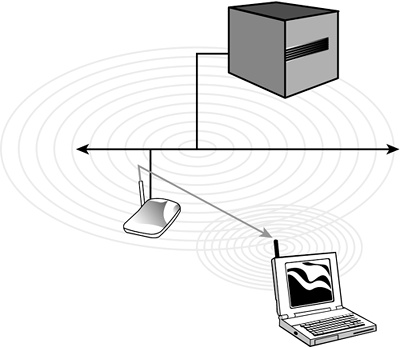Network Topologies
| A topology refers to both the physical and logical layout of a network. The physical topology of a network refers to the actual layout of the computer cables and other network devices. The logical topology of a network, on the other hand, refers to the way in which the network appears to the devices that use it. Several topologies are in use for networks today. Some of the more common include the bus, ring, star, mesh, and wireless topologies. The following sections provide an overview of each. Bus TopologyA bus network uses a trunk or backbone to which all of the computers on the network connect. Systems connect to this backbone using T connectors or taps. To avoid signal reflection, a physical bus topology requires that each end of the physical bus be terminated. Figure 1.3 shows an example of a physical bus topology. Figure 1.3. Physical bus topology.
The most common implementation of a linear bus is the IEEE 802.3 standard. Table 1.2 summarizes the advantages and disadvantages of the bus topology.
Ring TopologyThe ring topology is actually a logical ring, meaning that the data travels in circular fashion from one computer to another on the network. It is not a physical ring topology. Figure 1.4 shows the logical layout of a ring network. Figure 1.4. Logical design of the ring network.
In a true ring topology, if a single computer or section of cable fails, there is an interruption in the signal. The entire network becomes inaccessible. Network disruption can also occur when computers are added or removed from the network, making it an impractical network design in environments where there is constant change to the network. Ring networks are most commonly wired in a star configuration. In a Token Ring network, a multistation access unit (MSAU) is equivalent to a hub or switch on an Ethernet network. The MSAU performs the token circulation internally. To create the complete ring, the ring in (RI) port on each MSAU is connected to the ring out (RO) port on another MSAU. The last MSAU in the ring is then connected to the first, to complete the ring. Table 1.3 summarizes the advantages and disadvantages of the ring topology.
Star TopologyIn the star topology, all computers and other network devices connect to a central device called a hub or switch. Each connected device requires a single cable to be connected to the hub, creating a point-to-point connection between the device and the hub. Using a separate cable to connect to the hub allows the network to be expanded without disruption to the network. A break in any single cable will not cause the entire network to fail. Figure 1.5 provides an example of a star topology. Figure 1.5. Star topology.
The star topology is the most widely implemented network design in use today, but it is not without its shortcomings. Because all devices connect to a centralized hub, this creates a single point of failure for the network. If the hub fails, any device connected to it will not be able to access the network. Because of the number of cables required and the need for network devices, the cost of a star network is often higher than other topologies. Table 1.4 summarizes the advantages and disadvantages of the star topology.
Mesh TopologyThe mesh topology incorporates a unique network design in which each computer on the network connects to every other, creating a point-to-point connection between every device on the network. The purpose of the mesh design is to provide a high level of redundancy. If one network cable fails, the data always has an alternative path to get to its destination. Figure 1.6 shows the mesh topology. Figure 1.6. Mesh topology.
As you can see from Figure 1.6, the wiring for a mesh network can be very complicated. Further, the cabling costs associated with the mesh topology can be high, and troubleshooting a failed cable can be tricky. Because of this, the mesh topology is rarely used. A variation on a true mesh topology is the hybrid mesh. It creates a redundant point-to-point network connection between only specific network devices. The hybrid mesh is most often seen in WAN implementations. Table 1.5 summarizes the advantages and disadvantages of the mesh topology.
Wireless TopologyWireless networks are typically implemented using one of two wireless topologies: the infrastructure, or managed, wireless topology and the ad-hoc, or unmanaged, wireless topology. Infrastructure Wireless TopologyThe infrastructure wireless topology is commonly used to extend a wired LAN to include wireless devices. Wireless devices communicate with the wired LAN through a base station known as an access point (AP) or wireless access point (WAP). The AP forms a bridge between a wireless and wired LAN, and all transmissions between wireless stations, or between a system and a wired network client, go through the AP. APs are not mobile and have to stay connected to the wired network; therefore, they become part of the wired network infrastructurethus the name. In infrastructure wireless networks, there might be several access points providing wireless coverage for a large area or only a single access point for a small area such as a single home or small building. Ad Hoc Wireless NetworkingIn a wireless ad hoc topology, devices communicate directly between themselves without using an access point. This peer-to-peer network design is commonly used to connect a small number of computers or wireless devices. As an example, an ad hoc wireless network may be set up temporarily between laptops in a boardroom or to connect to systems in a home instead of a wired solution. The ad-hoc wireless design provides a quick method to share files and resources between a small number of systems. Figure 1.7 compares the ad hoc and infrastructure wireless network designs. Figure 1.7. Comparing wireless topologies.
|





